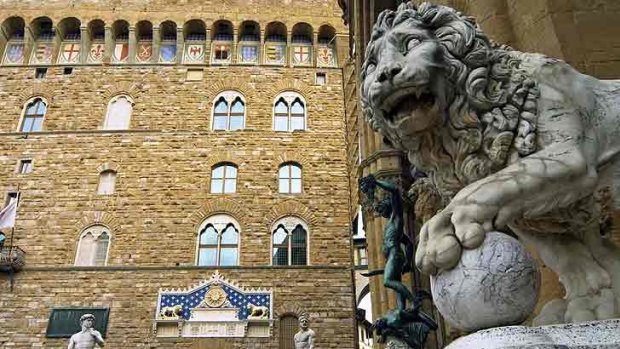
Grand designs ... the Piazza della Signoria and Palazzo Vecchio in Florence.
Harry Mount finds the driving force behind the Renaissance wasn't so much artistic endeavour as guilty repentance.
There's a pretty unromantic reason why the Renaissance sprouted in Florence - it's the place where modern banking was born. We like to think of art as a spiritual, sensitive calling, far removed from the ruthless desire for filthy lucre. But Botticelli, Michelangelo and da Vinci needed money as much as the rest of us — as a new exhibition in the Palazzo Strozzi reveals. If you are planning a winter break in Florence, it's a good way to get a grip on the city and its history.
During the Renaissance, the city was the golden source of money. The florin - the little gold coin that takes its name from Florence, minted there from 1252 - was the most trusted currency in Europe. Off the back of the florin, banker dynasties flourished in the city for three centuries.
The city you stroll through today was largely built by those bankers. Santa Maria Novella, constructed to a revolutionary classical design in 1461 by the architect Leon Battista Alberti, was paid for by the Rucellai banking family.
Palazzo Strozzi itself was commissioned in 1489 by the banker Filippo Strozzi. The Strozzi is the city's grandest Renaissance palace, with hulking cornices, fortress-like rusticated walls and its own internal piazza. It now has its own cafe, too, as well as a modern art gallery, the Strozzina, in the old wine cellars.
Bankers also paid for the art and sculpture that filled these palazzi and churches - often in a search for absolution from the terrible sin of usury, or lending money for interest. The exhibition has several Botticellis paid for by repentant bankers. They aren't as well known as Primavera or The Birth of Venus - which you can see down the road at the Uffizi, behind the massed crowds (visit at the last timed entrance slot, 4.45pm, to enjoy the gallery at its emptiest) - but Botticelli's Madonnas in the Strozzi are just as stirringly characteristic of the artist's ideal of womanhood, with their gold-tinted ringlets, green eyes and butter-wouldn't-melt expressions.
The kings of 15th-century Florence banking, and Botticelli's most generous sponsors, were the Medicis. You could spend days looking at art and buildings paid for by the Medicis alone. Their tombs were carved by Michelangelo in the Sagrestia Nuova of San Lorenzo church, itself designed by Filippo Brunelleschi and commissioned by the Medicis. Medici florins also paid for the Palazzo Medici-Riccardi and the Boboli Gardens behind the Palazzo Pitti.
A recent exhibition at the Uffizi explained the relationship between the Medicis, the city they controlled and the artists they patronised. The Uffizi is now one of the world's great galleries - it's so stuffed with Medici commissions that Caravaggio's Bacchus was only found in a storeroom in 1916, lost for so long in the embarrassment of riches. The Uffizi began life in 1560 not as a public gallery, though, but as yet another Medici pile - the Palazzo degli Uffizi, "the Palace of the Offices", where Cosimo Medici oversaw the city's guilds and government departments and kept his best pictures.
The palace was designed by Giorgio Vasari (1511-74), the painter and architect who decorated much of the neighbouring Palazzo Vecchio. He is best known, though, as the first Italian art historian, thanks to his book, The Lives of the Most Excellent Painters, Sculptors and Architects. It's a gossipy, extremely pro-Florence book but it was, and is, extremely influential, not least as the first book to call the Renaissance the Renaissance, or the Rinascita.
Looking at some of Vasari's rather amateurish paintings, you can see why he turned to writing. The architecture of the Uffizi, too, seems pedestrian in comparison with the palazzi next door, in Piazza della Signoria. The U-shaped Uffizi is rather odd-looking, turned inside out on itself, with its two classical facades staring across at each other all the way down to the Arno.
Still, Vasari had a lot to contend with. Having to build on unstable, sandy ground, he used an ingenious iron skeleton to stop the Uffizi falling into the river. Florence's light, airy beauty is secretly built on metal, precious or otherwise.
Telegraph, London
FAST FACTS
Getting there Swiss International Airlines has a fare to Florence from Sydney and Melbourne for about $2275 low-season return including tax. You fly with a partner airline to Hong Kong (about 9hr), then to Zurich (13hr), then to Florence (70min); see swiss.com. This fare allows you to fly via other Asian cities and back from another European city.
Staying there The Hotel Il Salviatino on Via del Salviatino, 21, Fiesole, in the hills above downtown Florence, has double rooms from euro 400 [convert] a night until December 20, and again from January 2 - March 31, 2012. Includes breakfast for two and city transfer. see www.salviatino.com.
While there Money and Beauty - Bankers, Botticelli and the Bonfire of the Vanities exhibition is at the Palazzo Strozzi until January 22. Entry costs 10 euro; see www.palazzostrozzi.org.
More information See firenzeturismo.it
Sign up for the Traveller Deals newsletter
Get exclusive travel deals delivered straight to your inbox. Sign up now.